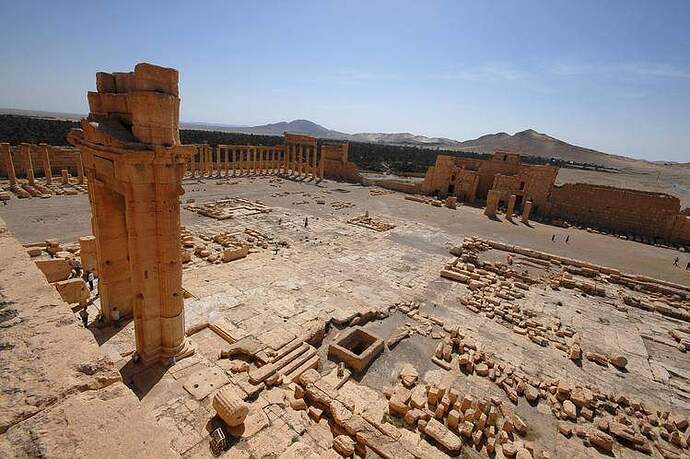Casting tiny columns from plaster at a make-shift workshop in the north of war-torn Syria, Ali Saleh patiently rebuilds a model of the ancient ruins of his lost hometown Palmyra.
Tens years of Syria’s war have robbed the 58-year-old of his home in the desert city, all four of his children, and the last of his poor hearing, his family says.
(Source: AFP)
https://www.presstv.com/Detail/2021/01/21/643555/Plaster-Displaced-Syrian-Palmyra-Ruins
Is this approx. 1/35?
The Temple of Bel was 200 x 200 meters, big square with columns and a smaller structure in the middle.
3D render of the central structure.

Before and after the ISIS idiots had destroyed the ruins
The Temple of Bel in the video (at 0:39) seems to be at most 2 x 2 meters (6’ 7") which would mean a 1:100 scale. In 1/35 the sides would 5.7 meters (almost 18’ 9") long. At 5:30 the video shows cars parked in fron of the temple ruins.
A reasonable assumption is that everything is rebuilt to the same scale.
1 Like
Thank you for very detailed reply. Yes, I see now that I under calculated the archway sizes. Palmyra was more massive than I thought.
1 Like
Buildings and trees are usually larger than we model builders think 
Nice to see the 3D render has some colour on the capitals of the columns; I suspect there would have been a lot more on the rest of the building, especially the roof decorations. Classical civilisations painted pretty much everything, most of the surviving marble statues that now appear pristine white were mostly painted, often with all the subtlety of a garden Gnome. Most wargamers don’t realise their artillery would have looked like something in a fairground, (IIRC) this is mentioned as an aside in Ctesibius’ description of his air-compression catapult.
Regards,
M
2 Likes
The classic Venus de Milo statue painted like a cheap pr-st-t-t- would be something to see,
or maybe not …
The Venus de Milo (Aphrodite of Melos) probably was painted (or polychromed as the term used by scholars has it) but this has now faded (which tends to happen quickly after excavation, c.f. The Alexander Sarcophagus) or eroded. This is likely because the statue originally had metal jewelry affixed which is now missing, similar to some of the soldiers on Trajan’s Column who originally held metal weapons. Although now stylistically dated as a much later work it was originally attributed to Praxiteles who did use the courtesan Phryne as a model for his Aphrodite of Knidos…
Regards,
M
1 Like



